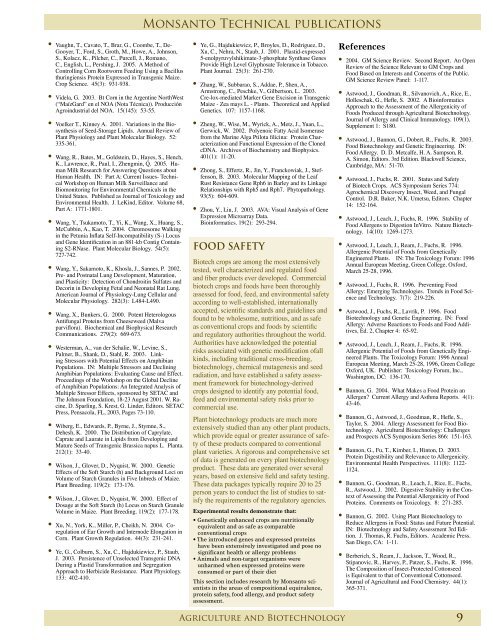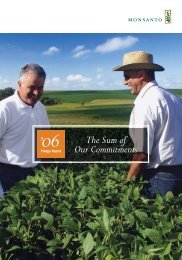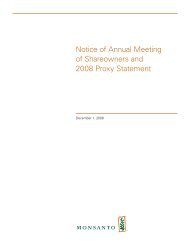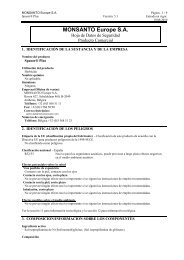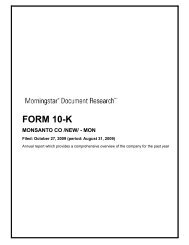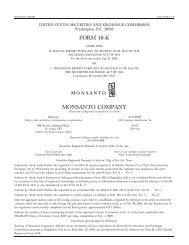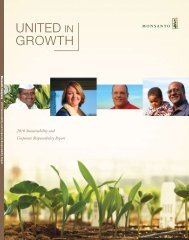Monsanto Technical Publications
Monsanto Technical Publications
Monsanto Technical Publications
Create successful ePaper yourself
Turn your PDF publications into a flip-book with our unique Google optimized e-Paper software.
•<br />
•<br />
•<br />
•<br />
•<br />
•<br />
•<br />
•<br />
•<br />
•<br />
•<br />
•<br />
•<br />
Vaughn, T., Cavato, T., Brar, G., Coombe, T., De-<br />
Gooyer, T., Ford, S., Groth, M., Howe, A., Johnson,<br />
S., Kolacz, K., Pilcher, C., Purcell, J., Romano,<br />
C., English, L., Pershing, J. 2005. A Method of<br />
Controlling Corn Rootworm Feeding Using a Bacillus<br />
thuringiensis Protein Expressed in Transgenic Maize.<br />
Crop Science. 45(3): 931-938.<br />
Videla, G. 2003. Bt Corn in the Argentine NorthWest<br />
(“MaízGard” en el NOA (Nota Técnica)). Producción<br />
Agroindustrial del NOA. 15(145): 53-55.<br />
Voelker T., Kinney A. 2001. Variations in the Biosynthesis<br />
of Seed-Storage Lipids. Annual Review of<br />
Plant Physiology and Plant Molecular Biology. 52:<br />
335-361.<br />
Wang, R., Bates, M., Goldstein, D., Hayes, S., Hench,<br />
K., Lawrence, R., Paul, I., Zhengmin, Q. 2005. Human<br />
Milk Research for Answering Questions about<br />
Human Health. IN: Part A: Current Issues- <strong>Technical</strong><br />
Workshop on Human Milk Surveillance and<br />
Biomonitoring for Environmental Chemicals in the<br />
United States. Published as Journal of Toxicology and<br />
Environmental Health. J. LeKind, Editor. Volume 68,<br />
Part A: 1771-1801.<br />
Wang, Y., Tsukamoto, T., Yi, K., Wang, X., Huang, S.,<br />
McCubbin, A., Kao, T. 2004. Chromosome Walking<br />
in the Petunia Inflata Self-Incompatibility (S-) Locus<br />
and Gene Identification in an 881-kb Contig Containing<br />
S2-RNase. Plant Molecular Biology. 54(5):<br />
727-742.<br />
Wang, Y., Sakamoto, K., Khosla, J., Sannes, P. 2002.<br />
Pre- and Postnatal Lung Development, Maturation,<br />
and Plasticity: Detection of Chondroitin Sulfates and<br />
Decorin in Developing Fetal and Neonatal Rat Lung.<br />
American Journal of Physiology-Lung Cellular and<br />
Molecular Physiology. 282(3): L484-L490.<br />
Wang, X., Bunkers, G. 2000. Potent Heterologous<br />
Antifungal Proteins from Cheeseweed (Malva<br />
parviflora). Biochemical and Biophysical Research<br />
Communications. 279(2): 669-673.<br />
Westerman, A., van der Schalie, W., Levine, S.,<br />
Palmer, B., Shank, D., Stahl, R. 2003. Linking<br />
Stressors with Potential Effects on Amphibian<br />
Populations. IN: Multiple Stressors and Declining<br />
Amphibian Populations: Evaluating Cause and Effect.<br />
Proceedings of the Workshop on the Global Decline<br />
of Amphibian Populations: An Integrated Analysis of<br />
Multiple Stressor Effects, sponsored by SETAC and<br />
The Johnson Foundation, 18-23 August 2001. W. Racine,<br />
D. Sparling, S. Krest, G. Linder, Editors. SETAC<br />
Press, Pensacola, FL, 2003, Pages 73-110.<br />
Wiberg, E., Edwards, P., Byrne, J., Stymne, S.,<br />
Dehesh, K. 2000. The Distribution of Caprylate,<br />
Caprate and Laurate in Lipids from Developing and<br />
Mature Seeds of Transgenic Brassica napus L. Planta.<br />
212(1): 33-40.<br />
Wilson, J., Glover, D., Nyquist, W. 2000. Genetic<br />
Effects of the Soft Starch (h) and Background Loci on<br />
Volume of Starch Granules in Five Inbreds of Maize.<br />
Plant Breeding. 119(2): 173-176.<br />
Wilson, J., Glover, D., Nyquist, W. 2000. Effect of<br />
Dosage at the Soft Starch (h) Locus on Starch Granule<br />
Volume in Maize. Plant Breeding. 119(2): 177-178.<br />
Xu, N., York, K., Miller, P., Cheikh, N. 2004. Coregulation<br />
of Ear Growth and Internode Elongation in<br />
Corn. Plant Growth Regulation. 44(3): 231-241.<br />
Ye, G., Colburn, S., Xu, C., Hajdukiewicz, P., Staub,<br />
J. 2003. Persistence of Unselected Transgenic DNA<br />
During a Plastid Transformation and Segregation<br />
Approach to Herbicide Resistance. Plant Physiology.<br />
133: 402-410.<br />
<strong>Monsanto</strong> <strong>Technical</strong> publications<br />
•<br />
•<br />
•<br />
•<br />
•<br />
Ye, G., Hajdukiewicz, P., Broyles, D., Rodriguez, D.,<br />
Xu, C., Nehra, N., Staub, J. 2001. Plastid-expressed<br />
5-enolpyruvylshikimate-3-phosphate Synthase Genes<br />
Provide High Level Glyphosate Tolerance in Tobacco.<br />
Plant Journal. 25(3): 261-270.<br />
Zhang, W., Subbarao, S., Addae, P., Shen, A.,<br />
Armstrong, C., Peschke, V., Gilbertson, L. 2003.<br />
Cre-lox-mediated Marker Gene Excision in Transgenic<br />
Maize - Zea mays L. - Plants. Theoretical and Applied<br />
Genetics. 107: 1157-1168.<br />
Zheng, W., Wise, M., Wyrick, A., Metz, J., Yuan, L.,<br />
Gerwick, W. 2002. Polyenoic Fatty Acid Isomerase<br />
from the Marine Alga Ptilota filicina: Protein Characterization<br />
and Functional Expression of the Cloned<br />
cDNA. Archives of Biochemistry and Biophysics.<br />
401(1): 11-20.<br />
Zhong, S., Effertz, R., Jin, Y., Franckowiak, J., Steffenson,<br />
B. 2003. Molecular Mapping of the Leaf<br />
Rust Resistance Gene Rph6 in Barley and its Linkage<br />
Relationships with Rph5 and Rph7. Phytopathology.<br />
93(5): 604-609.<br />
Zhou, Y., Liu, J. 2003. AVA: Visual Analysis of Gene<br />
Expression Microarray Data.<br />
Bioinformatics. 19(2): 293-294.<br />
FOOD SAFETY<br />
Biotech crops are among the most extensively<br />
tested, well characterized and regulated food<br />
and fiber products ever developed. Commercial<br />
biotech crops and foods have been thoroughly<br />
assessed for food, feed, and environmental safety<br />
according to well-established, internationally<br />
accepted, scientific standards and guidelines and<br />
found to be wholesome, nutritious, and as safe<br />
as conventional crops and foods by scientific<br />
and regulatory authorities throughout the world.<br />
Authorities have acknowledged the potential<br />
risks associated with genetic modification ofall<br />
kinds, including traditional cross-breeding,<br />
biotechnology, chemical mutagenesis and seed<br />
radiation, and have established a safety assessment<br />
framework for biotechnology-derived<br />
crops designed to identify any potential food,<br />
feed and environmental safety risks prior to<br />
commercial use.<br />
Plant biotechnology products are much more<br />
extensively studied than any other plant products,<br />
which provide equal or greater assurance of safety<br />
of these products compared to conventional<br />
plant varieties. A rigorous and comprehensive set<br />
of data is generated on every plant biotechnology<br />
product. These data are generated over several<br />
years, based on extensive field and safety testing.<br />
These data packages typically require 20 to 25<br />
person years to conduct the list of studies to satisfy<br />
the requirements of the regulatory agencies.<br />
Experimental results demonstrate that:<br />
• Genetically enhanced crops are nutritionally<br />
equivalent and as safe as comparable<br />
conventional crops<br />
• The introduced genes and expressed proteins<br />
have been extensively investigated and pose no<br />
significant health or allergy problems<br />
• Animals and non-target organisms were<br />
unharmed when expressed proteins were<br />
consumed or part of their diet<br />
This section includes research by <strong>Monsanto</strong> scientists<br />
in the areas of compositional equivalence,<br />
protein safety, food allergy, and product safety<br />
assessment.<br />
Agriculture and Biotechnology<br />
References<br />
•<br />
•<br />
•<br />
•<br />
•<br />
•<br />
•<br />
•<br />
•<br />
•<br />
•<br />
•<br />
•<br />
•<br />
•<br />
2004. GM Science Review. Second Report. An Open<br />
Review of the Science Relevant to GM Crops and<br />
Food Based on Interests and Concerns of the Public.<br />
GM Science Review Panel: 1-117.<br />
Astwood, J., Goodman, R., Silvanovich, A., Rice, E.,<br />
Holleschak, G., Hefle, S. 2002. A Bioinformatics<br />
Approach to the Assessment of the Allergenicity of<br />
Foods Produced through Agricultural Biotechnology.<br />
Journal of Allergy and Clinical Immunology. 109(1),<br />
Supplement 1: S180.<br />
Astwood, J., Bannon, G., Dobert, R., Fuchs, R. 2003.<br />
Food Biotechnology and Genetic Engineering. IN:<br />
Food Allergy. D. D. Metcalfe, H. A. Sampson, R.<br />
A. Simon, Editors. 3rd Edition. Blackwell Science,<br />
Cambridge, MA: 51-70.<br />
Astwood, J., Fuchs, R. 2001. Status and Safety<br />
of Biotech Crops. ACS Symposium Series 774:<br />
Agrochemical Discovery Insect, Weed, and Fungal<br />
Control. D.R. Baker, N.K. Umetsu, Editors. Chapter<br />
14: 152-164.<br />
Astwood, J., Leach, J., Fuchs, R. 1996. Stability of<br />
Food Allergens to Digestion InVitro. Nature Biotechnology.<br />
14(10): 1269-1273.<br />
Astwood, J., Leach, J., Ream, J., Fuchs, R. 1996.<br />
Allergenic Potential of Foods from Genetically<br />
Engineered Plants. IN: The Toxicology Forum: 1996<br />
Annual European Meeting, Green College, Oxford,<br />
March 25-28, 1996.<br />
Astwood, J., Fuchs, R. 1996. Preventing Food<br />
Allergy: Emerging Technologies. Trends in Food Science<br />
and Technology. 7(7): 219-226.<br />
Astwood, J., Fuchs, R., Lavrik, P. 1996. Food<br />
Biotechnology and Genetic Engineering. IN: Food<br />
Allergy: Adverse Reactions to Foods and Food Additives,<br />
Ed. 2, Chapter 4: 65-92.<br />
Astwood, J., Leach, J., Ream, J., Fuchs, R. 1996.<br />
Allergenic Potential of Foods from Genetically Engineered<br />
Plants. The Toxicology Forum: 1996 Annual<br />
European Meeting, March 25-28, 1996, Green College<br />
Oxford, UK. Publisher: Toxicology Forum, Inc.,<br />
Washington, DC: 136-170.<br />
Bannon, G. 2004. What Makes a Food Protein an<br />
Allergen? Current Allergy and Asthma Reports. 4(1):<br />
43-46.<br />
Bannon, G., Astwood, J., Goodman, R., Hefle, S.,<br />
Taylor, S. 2004. Allergy Assessment for Food Biotechnology.<br />
Agricultural Biotechnology: Challenges<br />
and Prospects ACS Symposium Series 866: 151-163.<br />
Bannon, G., Fu, T., Kimber, I., Hinton, D. 2003.<br />
Protein Digestibility and Relevance to Allergenicity.<br />
Environmental Health Perspectives. 111(8): 1122-<br />
1124.<br />
Bannon, G., Goodman, R., Leach, J., Rice, E., Fuchs,<br />
R., Astwood, J. 2002. Digestive Stability in the Context<br />
of Assessing the Potential Allergenicity of Food<br />
Proteins. Comments on Toxicology. 8: 271-285.<br />
Bannon, G. 2002. Using Plant Biotechnology to<br />
Reduce Allergens in Food: Status and Future Potential.<br />
IN: Biotechnology and Safety Assessment 3rd Edition.<br />
J. Thomas, R. Fuchs, Editors. Academic Press.<br />
San Diego, CA: 1-11.<br />
Berberich, S., Ream, J., Jackson, T., Wood, R.,<br />
Stipanovic, R., Harvey, P., Patzer, S., Fuchs, R. 1996.<br />
The Composition of Insect-Protected Cottonseed<br />
is Equivalent to that of Conventional Cottonseed.<br />
Journal of Agricultural and Food Chemistry. 44(1):<br />
365-371.<br />
9


